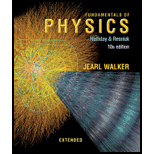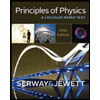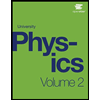
Fundamentals of Physics Extended
10th Edition
ISBN: 9781118230725
Author: David Halliday, Robert Resnick, Jearl Walker
Publisher: Wiley, John & Sons, Incorporated
expand_more
expand_more
format_list_bulleted
Textbook Question
Chapter 20, Problem 13P
In the irreversible process of Fig. 20-5, let the initial temperatures of the identical blocks L and R be 305.5 and 294.5 K, respectively, and let 215 J be the energy that must be transferred between the blocks in order to reach equilibrium. For the reversible processes of Fig. 20-6, what is ΔS for (a) block L, (b) its reservoir, (c) block R, (d) its reservoir, (e) the two-block system, and (f) the system of the two blocks and the two reservoirs?
Expert Solution & Answer
Want to see the full answer?
Check out a sample textbook solution
Students have asked these similar questions
Two moles of a diatomic ideal gas such as oxygen are compressed adiabatically and reversibly from an initial state (4.01 atm, 12.74 L) to a final state with a pressure of 6.82 atm. Assume that Cv=5R
Determine the change in the internal energy of the gas in this process (in J)
Consider 1 mole of an ideal gas at an initial pressure of 1.00 atm and initial temperature of 273.15 K. Assume it expands adiabatically against a pressure of 0.435 atm until its volume doubles. Calculate change in internal energy ΔU (in J) of the process.Answer in 3 SF
Compute the change in entropy for an ideal dry gas of mass M which is heated at constant volume from T 1 to T 2 . Take M = 1 kg, T 1 = 300 K and T 2 = 310 K.
Chapter 20 Solutions
Fundamentals of Physics Extended
Ch. 20 - Point i in Fig. 20-19 represents the initial state...Ch. 20 - In lour experiments, blocks A and B, starting ill...Ch. 20 - A gas, confined to an insulated cylinder, is...Ch. 20 - An ideal monatomic gas at initial temperature T0...Ch. 20 - In four experiments, 2.5 mol of hydrogen gas...Ch. 20 - A box contains 100 atoms in a configuration that...Ch. 20 - Does the entropy per cycle increase, decrease, or...Ch. 20 - Three Carnot engines operate between temperature...Ch. 20 - An inventor claims to have invented four engines,...Ch. 20 - Does the entropy per cycle increase, decrease, or...
Ch. 20 - SSM Suppose 4.00 mol of an ideal gas undergoes a...Ch. 20 - An ideal gas undergoes a reversible isothermal...Ch. 20 - ILW A 2.50 mol sample of an ideal gas expands...Ch. 20 - How much energy must be transferred as heat for a...Ch. 20 - ILW Find a the energy absorbed as heat and b the...Ch. 20 - a What is the entropy change of a 12.0 g ice cube...Ch. 20 - ILW A 50.0 g block of copper whose temperature is...Ch. 20 - At very low temperatures, the molar specific heat...Ch. 20 - A 10 g ice cube at 10oC is placed in a lake whose...Ch. 20 - A 364 g block is put in contact with a thermal...Ch. 20 - SSM WWW In an experiment, 200 g of aluminum with a...Ch. 20 - A gas sample undergoes a reversible isothermal...Ch. 20 - In the irreversible process of Fig. 20-5, let the...Ch. 20 - Prob. 14PCh. 20 - A mixture of 1773 g of water and 227 g of ice is...Ch. 20 - GO An 8.0 g ice cube at -10C is put into a Thermos...Ch. 20 - Prob. 17PCh. 20 - GO A 2.0 mol sample of an ideal monatomic gas...Ch. 20 - Suppose 1.00 mol of a monatomic ideal gas is taken...Ch. 20 - Expand 1.00 mol of an monatomic gas initially at...Ch. 20 - GO Energy can be removed from water as heat at and...Ch. 20 - GO An insulated Thermos contains 130 g of water at...Ch. 20 - A Carnot engine whose low-temperature reservoir is...Ch. 20 - A Carnot engine absorbs 52 kJ as heat and exhausts...Ch. 20 - A Carnot engine has an efficiency of 22.0. It...Ch. 20 - In a hypothetical nuclear fusion reactor, the fuel...Ch. 20 - SSM WWW A Carnot engine operates between 235C and...Ch. 20 - In the first stage of a two-stage Carnot engine,...Ch. 20 - GO Figure 20-27 shows a reversible cycle through...Ch. 20 - A 500 W Carnot engine operates between...Ch. 20 - The efficiency of a particular car engine is 25...Ch. 20 - GO A Carnot engine is set up to produce a certain...Ch. 20 - SSM ILW Figure 20-29 shows a reversible cycle...Ch. 20 - GO An ideal gas 1.0 mol is the working substance...Ch. 20 - The cycle in Fig. 20-31 represents the operation...Ch. 20 - How much work must be done by a Carnot...Ch. 20 - SSM A heat pump is used to heal a building, The...Ch. 20 - The electric motor of a heat pump transfers energy...Ch. 20 - SSM A Carnot air conditioner lakes energy from the...Ch. 20 - To make ice, a freezer that is a reverse Carnot...Ch. 20 - ILW An air conditioner operating between 93F and...Ch. 20 - The motor in a refrigerator has a power of 200 W....Ch. 20 - GO Figure 20-32 represents a Carnot engine that...Ch. 20 - a During each cycle, a Carnot engine absorbs 750 J...Ch. 20 - Prob. 45PCh. 20 - A box contains N identical gas molecules equally...Ch. 20 - SSM WWW A box contains N gas molecules, Consider...Ch. 20 - Four particles are in the insulated box of Fig....Ch. 20 - A cylindrical copper rod of length 1.50 m and...Ch. 20 - Suppose 0.550 mol of an ideal gas is isothermally...Ch. 20 - Prob. 51PCh. 20 - Suppose 1.0 mol of a monatomic ideal gas initially...Ch. 20 - GO Suppose that a deep shaft were drilled in...Ch. 20 - What is the entropy change for 3.20 mol of an...Ch. 20 - A 600 g lump of copper at 80.0C is placed in 70.0...Ch. 20 - Figure 20-33 gives the force magnitude F versus...Ch. 20 - The temperature of 1.00 mol of a monatomic ideal...Ch. 20 - Repeat Problem 57, with the pressure now kept...Ch. 20 - SSM A 0.600 kg sample of water is initially ice at...Ch. 20 - A three-step cycle is undergone by 3.4 mol of an...Ch. 20 - An inventor has built an engine X and claims that...Ch. 20 - Suppose 2.00 mol of a diatomic gas is taken...Ch. 20 - A three-step cycle is undergone reversibly by 4.00...Ch. 20 - a A Carnot engine operates between a hot reservoir...Ch. 20 - A 2.00 mol diatomic gas initially at 300 K...Ch. 20 - An ideal refrigerator does 150 J of work to remove...Ch. 20 - Suppose that 260 J is conducted from a...Ch. 20 - An apparatus that liquefies helium is in a room...Ch. 20 - GO A brass rod is in thermal contact with a...Ch. 20 - A 45.0 g block of tungsten at 30.0C and a 25.0 g...Ch. 20 - Prob. 71PCh. 20 - Calculate the efficiency of a fossil-fuel power...Ch. 20 - SSM A Carnot refrigerator extracts 35.0 kJ as heat...Ch. 20 - A Carnot engine whose high-temperature reservoir...Ch. 20 - SSM System A of three particles and system B of...Ch. 20 - Figure 20-36 shows a Carnot cycle on a T-S...Ch. 20 - Find the relation between the efficiency of a...Ch. 20 - A Carnot engine has a power of 500 W. It operates...Ch. 20 - In a real refrigerator, the low-temperature coils...
Additional Science Textbook Solutions
Find more solutions based on key concepts
A particle moves from the origin to the point x = 3 m, y = 6 m along the curve y = ax2 bx, where a = 2 m1 and ...
Essential University Physics (3rd Edition)
Determine whether refrigerant R410A in each of the following states is a compressed liquid, a superheated vapor...
Fundamentals Of Thermodynamics
Suppose that coherent red light were incident on a mask with four narrow slits a distance d apart. Use the tran...
Tutorials in Introductory Physics
Write each number in decimal form.
27. 7.77 × 108
Applied Physics (11th Edition)
Number of neutrons in the boron atom.
Glencoe Physical Science 2012 Student Edition (Glencoe Science) (McGraw-Hill Education)
Knowledge Booster
Learn more about
Need a deep-dive on the concept behind this application? Look no further. Learn more about this topic, physics and related others by exploring similar questions and additional content below.Similar questions
- In an isothermal process, one mole of an ideal monatomic gas at a temperature T is taken from an initial pressure P to a final pressure P/3. Using the convention that work is positive when it is done on the system, what is the work done during the process in terms of R and T?arrow_forwardTwo moles of a monatomic ideal gas such as oxygen is compressed adiabatically and reversibly from a state (3 atm, 5 L) to a state with a pressure of 4 atm. (a) Find the volume and temperature of the final state. (b) Find thetemperature of the initial state. (c) Find work done by the gas in the process. (d) Find the change in internal energy in the process. Assume CV = 5R and C p = CV + R for the diatomic ideal gas in the conditions givenarrow_forwardOne very special method for performing work is to do so reversibly. A change of state occurs reversibly if the external pressure equals the gas pressure throughout the change of state. If the change of state occurs isothermally (at constant temperature), then the expression for reversible work on an ideal gas is: w= -nRTln(V2/V1) A 4.00-mol sample of an ideal gas, initially at 331 K and occupying a volume of 3.4 L, does 2,765 J of isothermal reversible work on the surroundings. What is the final volume (in L)? Round your answer to the tenths (0.1) place.arrow_forward
- A four-cylinder spark-ignition engine has a compression ratio of 10.5, and each cylinder has a maximum volume of 0.4 L. At the beginning of the compression process, the air is at 98 kPa and 37C, and the maximum temperature in the cycle is 2100 K. Assuming the engine to operate on the ideal Otto cycle, determine (a) the amount of heat supplied per cylinder, (b) the thermal efficiency, and (c) the number of revolutions per minute required for a net power output of 45 kW. Assume variable specific heats for air.arrow_forwardConsider a two-step process where 2.00 mol argon is (1) heated at constant pressure from 300. K to 400. K, then (2) compressed isothermally until its volume is halved. Calculate the change in entropy for step 1 and 2 individually first, then the total entropy change. Comment on what is happening at each step and overall. Assume Cp = 5/2 R for a monatomic ideal gas. (answers: step 1 = 11.96 J/K; step 2 = -11.53 J/K; total = 0.43 J/K)arrow_forwardA mass of 0.05 kg of carbon dioxide (molar mass 44 kg/ kmol, gamma 1.3), occupying a volume of .03 m3 at 1.025 bar, is compressed reversibly until the pressure is 6.5 bar. Determine the final temperature, the work done on the CO2, and the heat supplied: i. When the process is according to the law pv1.4 = constant. ii. When the process is isothermal. iii. When the process takes place in a perfectly thermally insulated cylinder,arrow_forward
- One mole of an ideal gas, for which CV,m = 3/2R, initially at 298 K and 1.00 × 10^5 Pa undergoes a reversible adiabatic compression. At the end of the process, the pressure is 1.00 × 10^6 Pa. Calculate the final temperature of the gas. Calculate q, w, ΔU, and ΔH for this process.arrow_forwardA certain gas occupies a volume of 4.3 L at a pressure of 1.2 atm and a temperature of 310 K. It is compressed adiabatically to a volume of 0.76 L. Determine (a) the final pressure and (b) the final temperature, assuming the gas to be an ideal gas for which g = 1.4.arrow_forwardIf 10kg/min of air are compressed isothermally from p1=96kPa and V1=7.65m3/min to p2=620kPa, find the work, the change of entropy and the heat for (a) nonflow process and (b) a steady flow process with v1=15m/s and v2=60m/s.arrow_forward
- A cylinder contains 1.87 mol of a monatomic ideal gas at 3.6 × 105 Pa and 335 K. The gas is first compressed to half its initial volume while keeping the pressure constant. It then expands adiabatically to its initial volume and is finally heated at constant volume to its original pressure. What is the value of the initial volume and the net work of the cycle (in absolute value)arrow_forwardA hot-water stream at 70C enters an adiabatic mixing chamber with a mass flow rate of 3.6 kg/s, where it is mixed with a stream of cold water at 20C. If the mixture leaves the chamber at 42C, determine (a) the mass flow rate of the cold water and (b) the rate of entropy generation during this adiabatic mixing process. Assume all the streams are at a pressure of 200 kPa.arrow_forward
arrow_back_ios
arrow_forward_ios
Recommended textbooks for you
 Principles of Physics: A Calculus-Based TextPhysicsISBN:9781133104261Author:Raymond A. Serway, John W. JewettPublisher:Cengage Learning
Principles of Physics: A Calculus-Based TextPhysicsISBN:9781133104261Author:Raymond A. Serway, John W. JewettPublisher:Cengage Learning

Principles of Physics: A Calculus-Based Text
Physics
ISBN:9781133104261
Author:Raymond A. Serway, John W. Jewett
Publisher:Cengage Learning

Thermodynamics: Crash Course Physics #23; Author: Crash Course;https://www.youtube.com/watch?v=4i1MUWJoI0U;License: Standard YouTube License, CC-BY